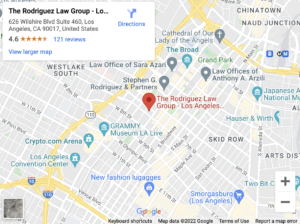The Impact of Racial Bias on Murder Cases in California

In California, a Black or Latino defendant is statistically far more likely to face harsher sentencing than a white defendant. This disparity increases in murder cases, especially when the victim is white.
These stark distinctions aren’t relics of the past—they’re a present-day reality, one that California has taken recent measures to address.
This article explores the impact of racial bias on murder cases in California, examining how this prejudice manifests in the courtroom and the legal measures, like the Racial Justice Act, aimed at correcting these injustices.
If you or a loved one is facing criminal charges, don’t navigate them alone. The Los Angeles criminal defense lawyer at Rodriguez Law Group is here to offer the legal defense you need to fight back against injustice. Call us today at (213) 995-6767 for your free consultation.
Uncovering Racial Bias in California’s Criminal Justice System
A 2024 study published in the Journal of Empirical Legal Studies analyzed over 27,000 murder and manslaughter cases in California from 1978 to 2002, highlighting a significant racial disparity: Black and Latino defendants were far more likely to receive the death penalty than white defendants.

This disparity especially showed in cases involving white victims, where prosecutors were more likely to seek the death penalty, and juries were more inclined to impose it.
These findings reflect a systemic issue within California’s broad definition of death penalty eligibility. The state’s legal framework allows for significant discretion in charging decisions, which conscious or unconscious racial biases can influence.
This broad discretion means that two defendants charged with similar crimes could face vastly different outcomes, depending on their race and the victim’s race.
Historical Context and Legal Precedents
Racial bias in California’s criminal justice system is not a new phenomenon. Historically, the state has struggled with racial inequities in its legal proceedings, particularly in capital cases.
The California Supreme Court’s decision in People v. Superior Court (Romero) (1996) allowed judges to dismiss enhancements and strike prior convictions in the interest of justice. Judges applied this ruling inconsistently, often to the detriment of defendants of color.
Moreover, the U.S. Supreme Court’s ruling in McCleskey v. Kemp (1987), which upheld a death sentence despite evidence of racial disparities, set a high bar for proving racial discrimination in capital cases.
This ruling effectively insulated many racially biased practices from legal challenge, allowing racial disparities in sentencing to persist for decades.
The Broader Impact of Racial Bias
These disparities impact public perception of the justice system, particularly in communities with historically higher rates of police interactions and incarcerations.
Demographics of death row populations indicate an overrepresentation of Black and Latino individuals compared to their overall population percentages, which raises questions about the equitable application of capital punishment.
The California Racial Justice Act of 2020
In response to growing concerns over racial disparities in the criminal justice system, California introduced the Racial Justice Act (RJA) in 2020. This legislation represented a significant shift in how the state addresses claims of racial bias in criminal cases, particularly those involving serious charges like murder.
Key Provisions of the Racial Justice Act
The RJA attempted to address racial bias at various stages of the criminal justice process.
It includes several key provisions:
- Prohibition of Race-Based Convictions and Sentences: The RJA explicitly prohibits seeking or obtaining a criminal conviction or sentence based on race, ethnicity, or national origin.
- Use of Statistical Evidence: One of the groundbreaking aspects of the RJA is its allowance for defendants to challenge their convictions and sentences using statistical evidence. This means that if a defendant can demonstrate, through data, that racial bias played a role in their case, they can seek relief under the RJA.
- Expanded Access to Evidence: The RJA also expands defendants’ ability to gather evidence related to racial bias. This includes access to relevant records that may show a pattern of racial discrimination in similar cases.
Legal Developments Since the RJA’s Enactment
Since its enactment, the RJA has factored in several high-profile cases, illustrating both its potential impact and the challenges in its implementation.
For example:
- Contra Costa County Case (2024): A judge dismissed gang enhancements against four Black defendants in a murder case after evidence showed racial bias in the charging decisions. This included data demonstrating that Black men accused of gang-related murders were significantly more likely to face harsher charges than defendants of other races.
Statistical Evidence and the California Racial Justice Act (RJA): How It Works
So, how exactly can you demonstrate racial bias under the RJA?
Here’s an overview:
Use of Statistical Evidence Under the RJA
Types of Statistical Evidence Permitted
- Disparities in Arrest Rates: Data showing racial differences in how often individuals are arrested for similar offenses.
- Differences in Charging Decisions: Analysis of whether certain racial groups are more likely to face harsher charges or enhancements for similar crimes.
- Sentencing Outcome Variations: Statistics that highlight discrepancies in sentencing severity based on the defendant’s race.
- Jury Selection Patterns: Evidence showing the exclusion of certain racial groups from juries, which can influence trial outcomes.
- Historical Data on Convictions: Longitudinal data that demonstrates systemic racial disparities in convictions over time.
Establishing a Prima Facie Case
 Under the RJA, defendants can use statistical evidence to establish a prima facie case of racial bias. Put simply, if you can prove the data shows significant disparities, there’s enough evidence to suggest a substantial likelihood that a violation of the RJA may have occurred in your charges.
Under the RJA, defendants can use statistical evidence to establish a prima facie case of racial bias. Put simply, if you can prove the data shows significant disparities, there’s enough evidence to suggest a substantial likelihood that a violation of the RJA may have occurred in your charges.
If you can establish a prima facie case, the court must hold an evidentiary hearing to determine if an RJA violation actually occurred. At this hearing, the burden will shift to the prosecution to provide a race-neutral reason for the disparity.
This represents a shift from previous legal standards, where proving racial bias required direct evidence of intent.
Aggregate Data Analysis
Defendants are not required to show intentional discrimination in their individual cases; instead, they can use aggregated (i.e., broader and systemic) data to highlight inequities across the system—so long as the courts can show how those systemic patterns relate to the specific case at hand.
Thus, while aggregate data can be powerful, it’s often most effective when combined with other forms of evidence, such as expert testimony or specific instances of bias in the case, to prove beyond a reasonable doubt that racial bias indeed occurred.
Challenges in Gathering and Presenting Statistical Evidence
Data Availability and Access
A significant hurdle in using statistical evidence under the RJA is the availability and access to reliable data. Many jurisdictions do not systematically collect data on race in criminal justice processes, making it difficult for defendants to obtain the necessary information.
Additionally, some prosecutors’ offices may be reluctant to share internal data, further complicating evidence gathering.
Sample Size Issues
Certain regions, especially in smaller counties or for less common offenses, may lack enough cases to draw statistically significant conclusions.
For example, in 16 California counties with small Black populations, not enough offenses in 2019 met minimum sample size requirements. This lack of data limits the ability to make meaningful comparisons and challenge racial disparities under the RJA.
Defining “Similarly Situated” Defendants
Another challenge lies in defining what it means for defendants to be “similarly situated.” Courts must determine which factors—such as offense type, criminal history, and circumstances of the crime—are relevant for comparison. Narrow definitions can reduce the sample size, making it harder to establish disparities, while broader definitions might introduce confounding variables.
Interpreting Complex Data in Court
Presenting statistical evidence effectively in court requires careful interpretation, often necessitating expert witnesses who can explain the significance of the data. However, opposing counsel can challenge these interpretations, challenging the methodology or relevance of the analysis.
Judges and juries may find complex statistical evidence difficult to understand, so even if the data shows a bias, they may not be fully convinced.
Accounting for Confounding Variables
Statistical analyses must account for various factors that could influence the outcomes besides race, such as socioeconomic status, age, gender, and local policing practices. Failing to control for these variables can weaken the argument that racial bias is the primary cause of the observed disparities.
Demonstrating Causality
While statistical evidence can show correlations between race and judicial outcomes, proving that race caused these disparities is more challenging than most people realize.
Courts may require additional evidence to establish that racial bias, rather than other factors, drove the disparities.
Challenges and Criticisms of the Racial Justice Act

While the public has largely hailed the RJA as a positive step toward addressing these racial disparities, its implementation has not been without its challenges and criticisms.
Below are some of the key issues that critics have brought up, and an analysis of how these criticisms have played out many years after the RJA’s implementation:
1. Increased Burden on the Judicial System
One of the primary criticisms of the RJA is the potential strain it could place on the judicial system.
Critics argued that the Act could lead to a surge in appeals and motions as defendants seek to challenge their convictions based on racial bias. This influx of cases could overwhelm courts, resulting in delays and a backlog that might hinder the administration of justice.
The increase in RJA claims has not yet overwhelmed the courts to the degree some critics initially feared.
The law’s phased implementation has helped manage the caseload:
- Initially, only those with cases from January 1, 2021, onwards could file claims.
- On January 1, 2023, those with convictions after January 1, 2015, could file claims.
- From January 1, 2026, all felony convictions regardless of date qualify.
This gradual rollout has allowed courts to adapt over time rather than face an immediate deluge of cases. However, courts have had to allocate resources away from other services to handle RJA hearings.
As the eligibility window continues to roll out, we will see if the court system can handle the increase in cases without any major consequences.
2. Challenges in Proving Racial Bias
Critics have noted that proving racial bias will always be inherently challenging. As mentioned previously, establishing a clear connection between the statistical disparities and their individual cases typically involves complex data analysis and expert testimony, which can be difficult to present and interpret in a courtroom setting.
Additionally, defining what constitutes similarly situated defendants for comparison purposes adds another layer of complexity.
This issue has, so far, proven to be a significant hurdle. Courts are still deciding exactly what factors make defendants comparable—overly narrow definitions have sometimes limited the available sample size for comparison, whereas overly general definitions are not specific enough to show the case is comparable.
3. Potential for Unintended Consequences
Critics have expressed concerns about the potential unintended consequences of the RJA. For example, the Act could lead to inconsistent outcomes if courts interpret the evidence of racial bias differently.
The RJA might inadvertently result in defendants receiving different treatment based on race, contrary to the Act’s intent. Some fear that this could lead to reverse discrimination claims or other legal challenges that could undermine the RJA’s goals.
So far, no notable cases have materialized. However, some prosecutors have grown cautious in charging decisions, particularly regarding gang enhancements, to avoid potential RJA challenges.
This has led some to point out that it could lead to a dismissal of valid charges or the reduction of appropriate sentences based on perceived rather than actual bias. This, in turn, could lead to distrust in the justice system, which some may perceive as overly concerned with outward righteousness rather than true justice.
Get the Justice You Deserve

Ambrosio E. Rodriguez, Los Angeles Criminal Defense Attorneys
The RJA represents a pivotal step in addressing these racial disparities, but the Act’s implementation has not been without its challenges. The entire nation will be closely watching how its long-term impact pans out.
If you or a loved one is facing criminal charges and believe racial bias may have influenced the case, contact The Rodriguez Law Group Los Angeles Criminal Defense Attorneys today at (213) 995-6767 to discuss your case and explore your legal options.


